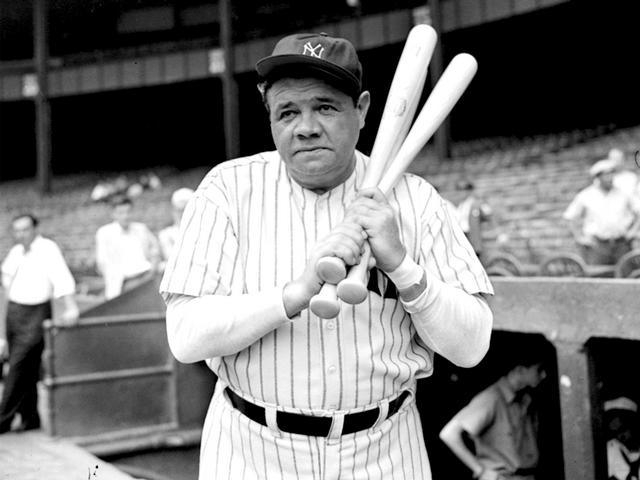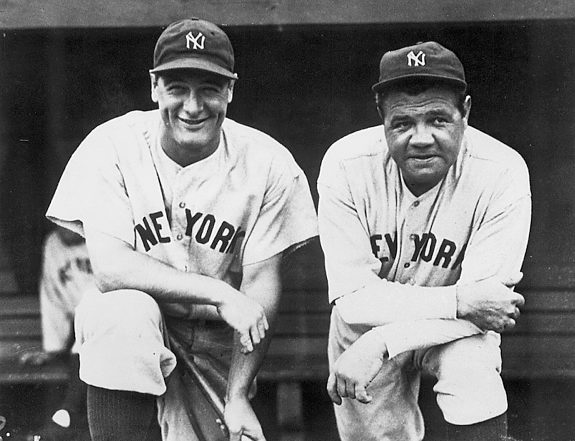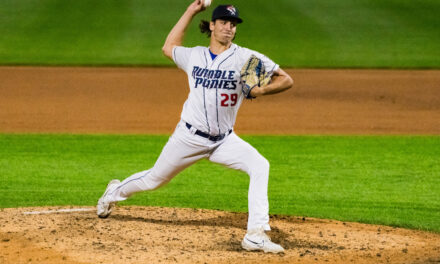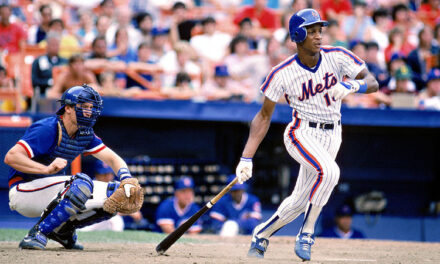
Babe Ruth has been dead for over seventy years, but he’s been haunting Jane Leavy’s mind for over two decades.
Leavy, the New York Times best-selling author whose works include heavily researched biographies on Hall of Famers Sandy Koufax and Mickey Mantle, had been planning to write a then-novel on the most celebrated and by most standards, greatest Major League Baseball player of all-time back in 1995.
Due to the voluminous works that were written on Ruth, Leavy felt it necessary to go the fictional route, in order to better “inhabit the caricature that he had become” as she says. She did not want to recycle the same information that had appeared in endless pages dedicated to Ruth in years past.
Sidetracked with her aforementioned works on Koufax and Mantle, Leavy returned to her Ruth project in 2011, when she met with his daughter, Julia Ruth Stevens, who is now 102-years-old. It was during a sit-down with Julia that her initial idea of writing a novel shifted.
Julia informed Leavy that Ruth’s father, George Sr., and mother Kate were separated, information that was not privy in previous works on Ruth.
While Leavy didn’t have the opportunity to speak with former contemporaries of Ruth, as other notable writers had, what she did have was the digitization of archived resources at her disposal. It was through a simple Google search that she further researched Julia’s claim of Ruth’s parents being separated. What she found was not only were they separated, but George Sr. had filed for divorce from his wife after he found her in a comprising position with his bartender at the saloon he owned in Baltimore.
With reams of information at her fingertips – literally – Leavy was able to compile a profusion of information pertaining to Ruth’s childhood, which up until this point was filled with many myths and just plain falsities.
This amounted to her penning a six-hundred-plus-page biography titled “The Big Fella: Babe Ruth and the World He Created.” In it, Leavy dispels several decades-long myths, including the real reason Ruth was sent to St. Mary’s Industrial School for boys at the age of seven.
The book revolves around Ruth and Lou Gehrig’s 1927 barnstorming tour, after a season in which Ruth hit 60 home runs – a total that would not be exceeded until Roger Maris in 1961 – and Gehrig fresh off his first M.V.P. season. The book traces the superstars’ tour in fantastic detail while eschewing every career highlight. Instead, Leavy focuses on how Ruth transcended the game not only on the field, but off it.
With the help of Christy Walsh, who pioneered the sports agent role, Ruth became a cultural phenomenon who made appearances in films, advertisements, and ghostwritten columns. With help from Walsh, Ruth ultimately became the model for the modern celebrity athlete.
Beyond the adulation Ruth was constantly met with, was a man who needed the spotlight and people who loved him around. Being brought up in St. Mary’s, where they were overcrowded with young boys, Ruth knew and was used to being around large crowds, and felt at his best in those situations.
Understanding that notion, what the book does a superb job of is retracing young Ruth’s childhood in detailed form, to illustrate what made Little George – as his parent’s called him – into the Big Fella.
I had the pleasure of speaking with Leavy in late December, where we discussed how long she had thought about writing a book on Ruth, who Christy Walsh was and how important he was in Ruth’s life and debunking some decades-long myths.
MMO: How long had you been thinking of writing a book on Babe Ruth and what was the process like?
Leavy: It was basically a nightmare. I’ve been thinking about it probably since 1995. That was when I took my then seven-year-old son to the Babe Ruth Birthplace and Museum in Baltimore. At that point, the trip was for me to introduce him to the Babe, but also for me to research into what I thought would be a novel about Babe Ruth.
I somehow got sidetracked doing Sandy Koufax and then Mickey Mantle. When they were done, where do you go? Where do you go after Koufax? You go to Mantle. Where do you go after Mantle? You go to Babe Ruth. And don’t ask me where I go next because I have no clue. [Laughs.]
MMO: I read in an interview you gave with another outlet that you took a full year just to read all the biographies already written about Ruth for your research.
Leavy: Yeah, I had to persuade myself before I could persuade anybody else that there was a new way to tell the story about Babe Ruth, and a new story to tell. After [Abraham] Lincoln, Muhammad Ali and a couple of other people, he is one of the most written about guys of the twentieth century.
He [Ruth] was written about repeatedly, and repeatedly well, starting with Bob Creamer in 1974. I had to be sure that there was something that I could add to what they had already done. I was very skeptical that I would find new material about him; my friends will tell you I was a bore for months!
There was nobody who was presently alive who I wanted to speak to who I could speak to because most of them are dead. I was able to get to some family members and to some elderly gentlemen who had seen him play. I knew that I wouldn’t have access to the teammates, opponents, managers, general managers, and Yankee officials that some of the other biographers had been able to speak with.
The only place that I was going to find stuff that was new was in archives. Those archives weren’t available in 1974, not in any way that you could easily access. As it turned out, there was plenty for me to write that was new.
Just as I didn’t have access to the living voices, Bob et al. didn’t have access to the voices that emerge out of legal documents that I was able to find at the Maryland State Archives and to newspaper articles. While they would’ve been in microfilm, you would’ve had to spend your whole life going through reams of tape in order to find what I could find with a click of the mouse.

Player’s Tribune
MMO: I loved what you wrote in the introduction of your book about how Cal Ripken Jr. wanted to hold Ruth’s bowling ball at the Hall of Fame, so he could stick his fingers in the holes to see how wide his hand and spread were. Can you talk about that story a little bit, including what you found out about the diameter of his thumb?
Leavy: In June 2014, as a celebration of the 100th anniversary of Ruth’s debut in the major leagues for the Boston Red Sox, the Hall of Fame opened a new Babe Ruth exhibit, which was the first new one in thirty years. I made sure to be there and I was remembering what I had seen of him when I was a child and remembering his big red locker from Yankee Stadium standing sort of by itself, like a totem. Its doors were flung open so you could see the stenciled white letters “Ruth” and the number three.
I get to this redone thing, which was upstairs on the second floor, and museums have changed a lot in the way they present things. It’s in a dim room with black ceilings and Tom Shieber, the curator who is a very good friend and helped me a lot, had organized it sort of like a scrapbook if you were walking through his life.
By the time you get to the locker, it’s sort of subsumed in dark museum cabinetry and it’s filled up with a bat of his, a picture of him sitting by the locker on his last visit to Yankee Stadium, silver loving cup that had been given to him, and all sorts of stuff. It’s become sort of an exhibit case more than an object.
While I’m standing there looking at it, I’m feeling claustrophobic on his behalf because I’m thinking, This is not big enough for the Babe. This is too dark for the Babe. He needs green grass; he needs wide expanses to gallop after fly balls.
As I’m trying to make myself stay there, Cal Ripken Jr. – who I covered as a young reporter for The Washington Post – in fact, I covered him in his rookie year, comes over to me and says, “Come here, I’ve got to show you something!”
He dragged me over to I think the last display cabinet where they had Babe Ruth’s blue and black paisley custom drilled bowling ball. After Babe retired in June 1935 and baseball couldn’t find anything or any place for him in the game, he spent a lot of time bowling, mainly by himself. And so this is the ball that he had used and Cal says to me, in that very Cal way of his, “Gee, I wish I could stick my fingers in Babe’s ball.” [Laughs.]
I looked at him like, ‘Oh, come on, Cal. You realize what you just said?’
He really wanted to feel the spread of his hand. As silly as the initial statement sounded, what he was saying was here’s a great athlete of the late twentieth century, trying to get a grip and literally feel what was the greatness of Babe Ruth. He wanted to do that by feeling how large his hands were because he can’t get a tactile feel for the Babe any other way. So I said, ‘No problem, Cal. We can do that. I know there’s another ball downstairs.’
I went off to get Tom Shieber and we were all set to go downstairs, but by that time, Cal had disappeared. What I did was, I got a bowling ball expert from Oneonta to come in with his bowling ball measuring tools and he measured the distances between the thumb hole and the middle finger, the thumb hole and the pointer finger, which were ample; four inches and the other one was about a quarter-inch shy of that.
The guy figured that the spread of his hand must’ve been about ten inches, which is plenty big but not overwhelming for big guys today. What blew him away was the diameter of the thumb hole. He measured that Babe Ruth’s knuckle on his left hand would’ve been exactly 1 3/32 inches wide; that’s approximately the size of an unshelled walnut.
If you want to know what made Babe Ruth, Babe Ruth, why he could equally handle a 54-ounce bat and make a baseball dance from the pitcher’s mound, that’s the reason.

MMO: That anecdote very early on stuck with me, especially in relation to how he could handle such a big bat for his career.
Leavy: You know what’s funny? When I started writing about Sandy Koufax back when, people would say to me, “Have you shook his hand?”
I said, ‘No, not yet.’
Well then I did, and I’m not a big person, but my hand splayed out and sits in the palm of his hand. When he shook my hand it reached all the way up past my elbow.
They were trying to say to me very much the same thing about Ruth. Look at what he was physiologically able to do in the way he held a ball and could make it do what he wanted to at his behest.
MMO: One of the myths you debunk in the book was the fact that young George was not an orphan or an incorrigible. Can you touch on what you found out about why he was sent to St. Mary’s?
Leavy: We live in such a different time than the one he grew up in. Today, if you have family woes and a tough growing-up story, somebody pitches it to an online magazine or a cable show and you get sympathy votes for that. In Babe Ruth’s era, when he was coming up, this was nothing to brag about and nothing to talk about.
In the absence of fact, two colliding myths grew up. One was, why did he get sent to St. Mary’s Industrial School? Why did he spend his childhood there?
Many people assumed, and some still do, that he was an orphan because people thought St. Mary’s was an orphanage. It was not. It was a reform school that also took in some orphans, some wayward boys, and some incorrigibles, which was a legal term for boys who were sent by the courts because they had gotten in trouble with the law.
The other myth about Babe was that he was one of those incorrigibles, that he had been a roustabout kid, running amok on the waterfront of Baltimore and that his parents had gotten a friendly justice to send him to St. Mary’s. And this is where those documents and archives we were speaking about turn up.
I went to interview Babe Ruth’s daughter, Julie -who’s still alive at age 102 – back in 2011, that’s when I started working on this. And she said to me out of absolutely nowhere from nothing I was smart enough to ask, “Well, you know, George Sr. [Babe’s father] and his mother Katie were separated.”
I did a double-take and said, ‘No, I didn’t know that!’ And Babe Ruth certainly never said that in the thousands of interviews.
All I had to do was go to my computer and type in George Herman Ruth Sr. v. Katie Ruth adding the legal versus, and guess what pops up? What pops up in the archives is the entire case file for not a separation, but a divorce. The reason Babe Ruth was sent to St. Mary’s was that his parent’s marriage was stormy, tempestuous and fraught with loss after loss after loss of children. By the time Babe Ruth was seven and was sent to St. Mary’s, he had seen the death of four siblings; two from malnutrition that I found in death certificates in the archives.
In March 1906, George Sr. found his wife in a comprising position with the bartender at George’s saloon, and he threw her out. Had she and the bartender arrested and immediately filed for divorce which was granted two months later in May 1906. She never came back to the family home as far as I could tell except to pick up her clothing and the depositions in the divorce are ugly and tawdry and sad beyond belief. Once that marriage was completely dissolved, George Sr. didn’t have any time or interest in raising his son.
MMO: While your book is on Babe Ruth, another huge component of Ruth’s adult life and who you write extensively about is Christy Walsh. Talk about the role Walsh played in Ruth’s growing fame.
Leavy: Christy Walsh was, in fact, the model for Jerry Maguire. And while he didn’t stick out his hand and say, “Show me the money,” that’s basically what he was doing. He was the first guy to do that for a baseball player in a very systematic way.
Their relationship started in February 1921. Everybody wanted a piece of the Babe and Christy was out of work and was fired from yet another job. [He] found out where he was staying, climbed up a fire escape, and found a window to Ruth’s hotel room open, this is according to Christy’s nephew, Richard. [He] climbed through the window, slapped him on the butt, and said, “I want to represent you.”
This resulted in a one-year deal to allow Walsh to syndicate ghostwritten byline columns under Ruth’s name. Ghostwritten columns, at that point, before radio and before pre-game shows and before reporters went down to get locker-room quotes routinely, those were the ways that a player allegedly could speak to his fans. Everybody sort of knew that they weren’t really true or real, but it didn’t really matter, people ate them up.
By the middle of the twenties, Christy Walsh – who was trained as a lawyer but never practiced – had legal rights to manage all of his money and basically saved him from himself, because absent Christy Walsh, he [Ruth] would’ve spent every cent that he had and ended up in the poor house.

MMO: Talk a bit about the relationship between Ruth and Lou Gehrig.
Leavy: The book as you know recreates their 1927 barnstorming tour; I wanted to let readers feel what it was like to be Babe Ruth at the absolute apex of his fame. To feel what it was like to be around him. I specifically chose not to do the conventional biographical beginning, middle, end, because I had figured that had been done pretty well already.
In 1927, Lou Gehrig is what my grandmother would’ve called a pisher; he was a young guy, he was 24, and had won the Most Valuable Player Award because Babe Ruth wasn’t allowed to win it a second time, he had won it in ’23. And he was in awe of Ruth.
What comes across in the articles I was able to access through the Library of Congress and newspapers dot com and all those local stories was it was such a big deal that they came through their town. The local writers wrote the byplay between them and what the relationship was like between them. It was at that point affectionate and it was maybe brotherly. Christy Walsh used that to promote Ruth as the wise elder, which was kind of hilarious in retrospect.
Gehrig had never been west of St. Louis and in Ogden, Utah, where they changed trains on the route to California on this barnstorming tour, they went for a ride through the canyon. Gehrig was so naive that he was disappointed that there were no cowboys and Indians and he said something like, “Well, it sure was an education to go around with the Babe.” [Laughs.] I bet it was!
I think the relationship was good then and not exactly equal, that would change later, will become fraught later. But in this point and time, it was quite a good relationship.
MMO: The inside cover of your book features a picture of hundreds of boys trying to cram themselves in to take a picture with Ruth after an exhibition game in 1925. Ruth looks completely unfazed, in fact, he’s smiling and looks to be genuinely enjoying the attention.
After reading your book and piecing his life together, I came away thinking that Ruth enjoyed the spotlight and adoration so much because of his tragic upbringing. Losing at least four siblings and still being placed in a reform school and having a feeling of being unwanted, did you get the sense that Ruth was at his best when he was around others?
Leavy: Yes. One thing that Julia told me, I asked her what he said about St. Mary’s, and she said, “He only said one thing ever. That he never felt full.” Which I think is a statement of actual hunger, because the Xaverian brothers had a lot of boys they had to care for and not that much money, and they had meat once a week, and guess what? It was hot dogs. Is it any wonder that he’d gorge himself on them later?
Those kids lived head to toe in long rows of metal cots that were separated just wide enough apart that they could get down and say their prayers at night. There was nothing personal to distinguish one child’s bed or place from another. They slept together, bathed together, went through puberty together and they played baseball together.
And what Babe Ruth learned at St. Mary’s – in addition to how to make a shirt collar or how to throw a baseball and how to hit one – was how to be public. That’s what was comfortable for him. That’s where he felt most at home in his skin. What he couldn’t do, and what was so hard for him, his second wife Claire would say later, was being alone.
At the end of his career in June 1935, when baseball could find no useful place for him in the entire game, and the institution that he had made and thought of as a family, turned their back on him, it was a replication of the abandonment in his childhood and I think it was excruciating for him.
MMO: After you compiled all your research and finished the book, did your perception of Ruth change for the better or worse?
Leavy: What I wanted to do when I was first going to write a novel, I wanted to write a novel because I wanted to inhabit the caricature that he had become. I thought there was no other way to do it other than fictionally. I was wrong as it turned out. I couldn’t understand or anticipate what history and the digital revolution was going to give me, so I was able to do it with actual fact instead of with gut reaction.
I came to admire him even more than I did when I started out because his parent’s abandoned him and imagine how he felt; he was seven-years-old and they had lost four children and there were only two left. They may have lost six but I could only find documentation for four, and they still didn’t want him. That’s got to feel pretty awful and he was left at St. Mary’s to make a self and to make a life and he did it. That it was flawed, that he didn’t know how to be a parent or a husband when he came out of St. Mary’s is hardly surprising and he’s certainly not the only major leaguer about whom you could say that.
And he did change over time and he was quite frustrated as I read in a 1963 story by a young guy named Jhan Robbins, who had visited him as a high school reporter in the Yankee locker room in 1934. Jhan had asked about not being asked to be the Yankees manager, which was, of course, the talk of all the tabloids and all the papers in New York. And Ruth went nuts on him! “That’s what’s wrong with all of you newspaper guys,” to a fourteen-year-old kid. “You never give a guy a chance to change. Wasn’t I good to you? Didn’t I always give you things to write about? Can’t you see that I’ve changed? Sure, I ran around in my time, but I’m different now.”
Babe Ruth learned the lesson that so many celebrities have learned since. Since he was the model for celebrity, which is if you create a persona – and he certainly colluded in the creation of the persona of the guy that ate too much, drank too much, stayed out late too much – you’re going to get trapped in it. And it’s going to be very hard for people to accept that you’re not necessarily that person anymore if you were that person ever.
MMO: Thanks very much for your time today, Jane. The book was a terrific read and I wish you all the best with it.
Leavy: Thanks so very much.
Follow Jane Leavy on Twitter, @janeleavy1
Visit Jane’s website here.
You can purchase “The Big Fella: Babe Ruth and the World He Created” here.















